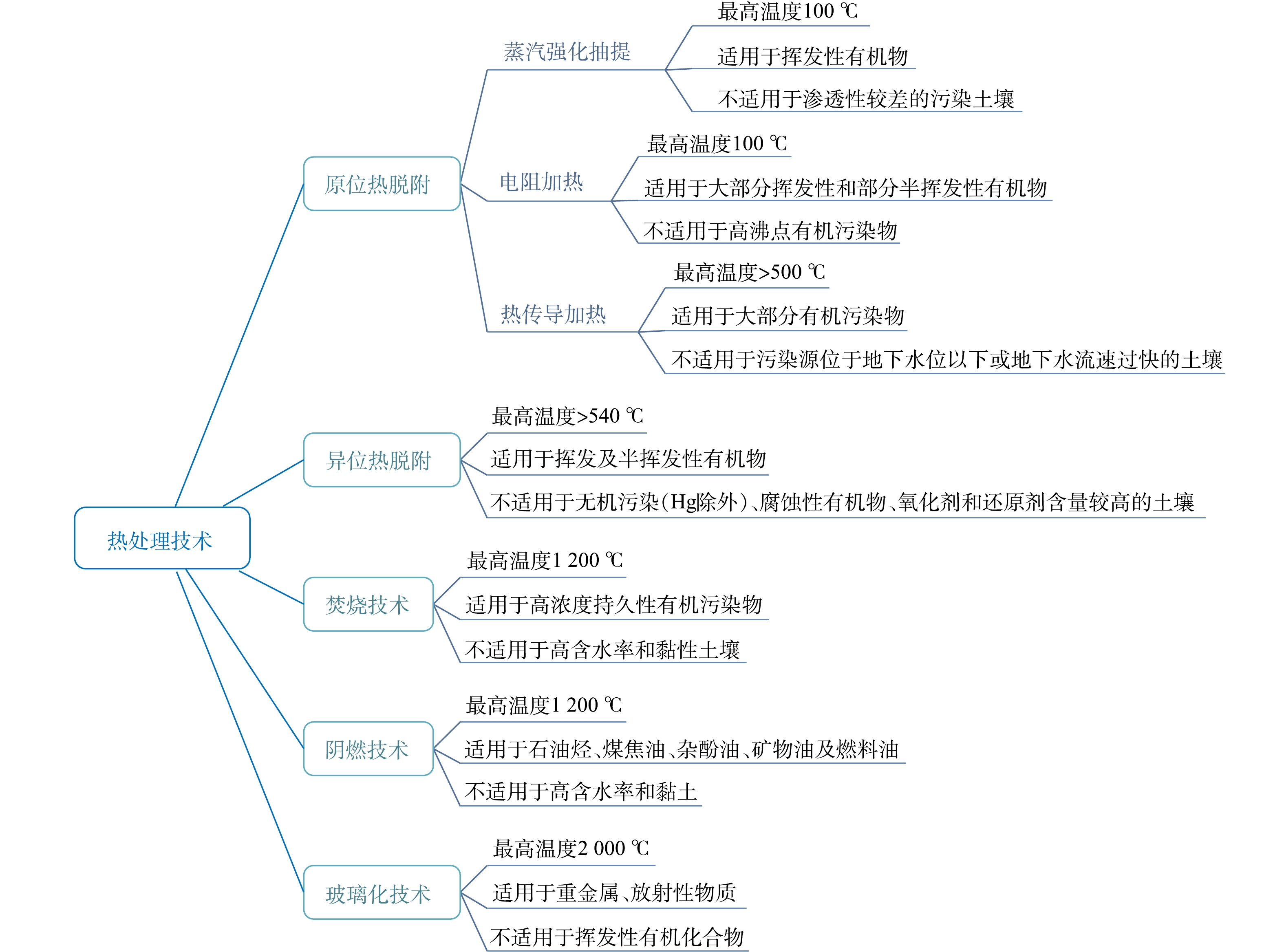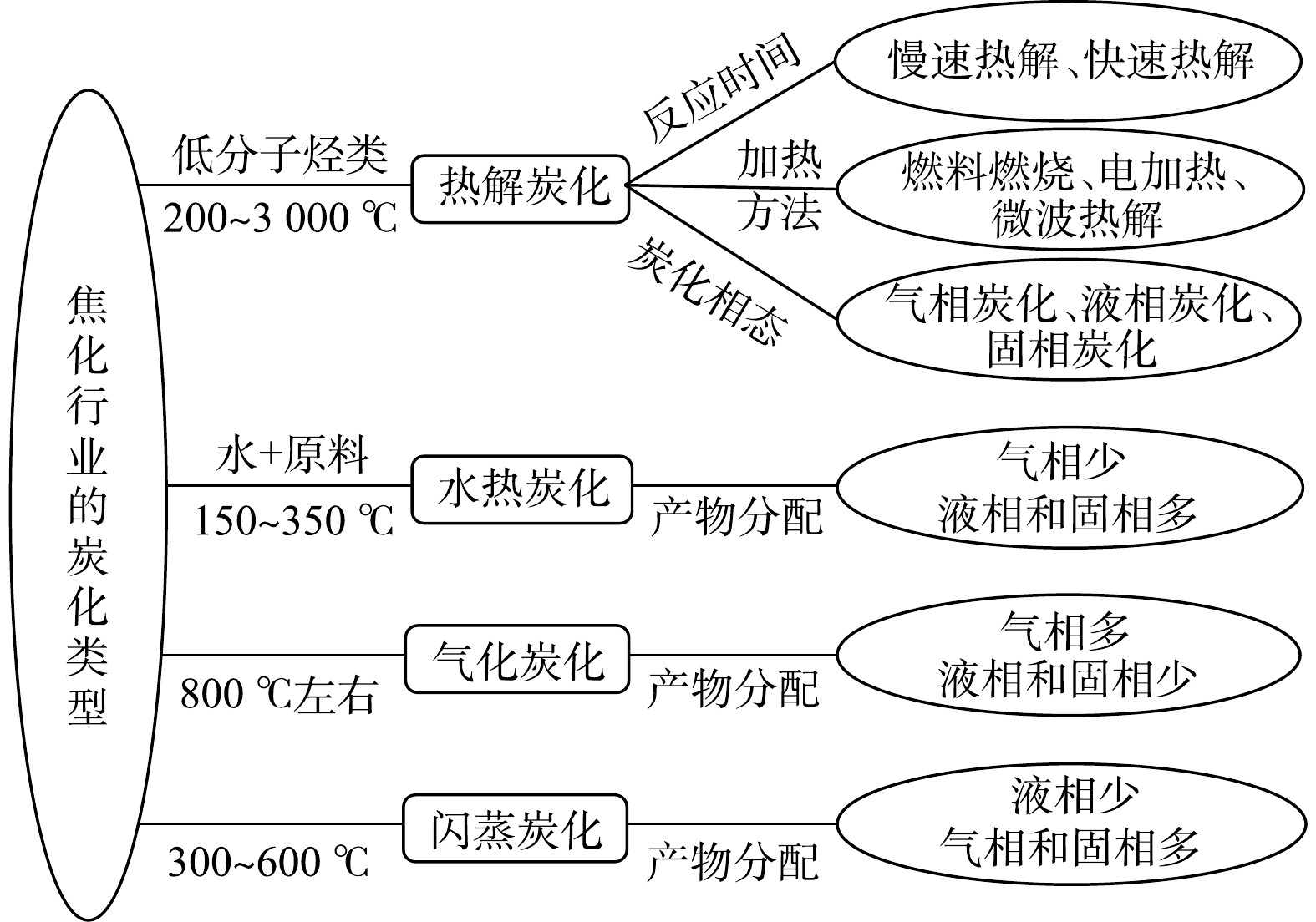2.中国环境科学研究院,环境基准与风险评估国家重点实验室,北京 100012
1.Department of Environmental Engineering, Beijing Institute of Petrochemical Technology, Beijing 102617, China
2.State Key Laboratory of Environmental Criteria and Risk Assessment, Chinese Research Academy of Environmental Sciences, Beijing 100012, China
热处理技术在国内外均占有较高的市场份额,已成为有机污染场地的主要修复技术。尽管对热处理技术本身的研究和关注较多,包括工艺、参数、能源、效果、成本、应用等方面,但关于有机污染物热处理化学转化中炭化行为研究的报道并不多见。炭化行为可能会改善土壤再利用特性,对热处理工艺参数也可能有一定影响。指出了传统焦化行业中4种炭化反应类型及其机理过程,梳理了石油烃和芳烃化合物等污染土壤热处理过程中的炭化行为,总结了有机污染物炭化行为对土壤再利用特性的影响,并分析了生物质炭化产物对土壤肥力的促进机制。以此为基础,提出了有机污染土壤热处理炭化行为研究的几个重点关注方向。
Thermal treatment technologies occupy a high domestic/foreign market share, and have become the main remediation technology of organic contaminated sites. Though many studies and concerns are focused on the process, parameters, energy, effect, cost and application of thermal treatment, there are few literature reports on the charring behaviors in the thermochemical conversion of organic pollutants. The charring behaviors may improve reusability of soil and affect process parameters of thermal treatment. Four types of charring reactions and their mechanisms are shown in this paper, and the charring behaviors of petroleum hydrocarbons and aromatic compounds during thermal treatment are reviewed. The effects of organic pollutants charring on soil reusability is summarized, and the improvement of biochar to soil fertility is analysed. Based on the mentioned above, several important research topics of charring process during thermal treatment of organic contaminated soil are proposed.
.
Classification, characteristics and applicability of soil thermal remediation technology
Charring classification and summary of their reactions
Charring and graphitization processes of organic compounds
Related research on charring reaction of organic pollutants during thermal treatment
| [1] | 赵涛, 马刚平, 周宇, 等. 多环芳烃类污染土壤热脱附修复技术应用研究[J]. 环境工程, 2017, 35(11): 178-181. |
| [2] | LIU J, ZHANG H, YAO Z, et al. Thermal desorption of PCBs contaminated soil with calcium hydroxide in a rotary kiln[J]. Chemosphere, 2019, 220: 1041-1046. doi: 10.1016/j.chemosphere.2019.01.031 |
| [3] | 蒋村, 孟宪荣, 施维林, 等. 氯苯污染土壤低温原位热脱附修复[J]. 环境工程学报, 2019, 13(7): 1720-1726. |
| [4] | 焦文涛, 韩自玉, 吕正勇, 等. 土壤电阻加热技术原位修复有机污染土壤的关键问题与展望[J]. 环境工程学报, 2019, 13(9): 2027-2036. |
| [5] | VIDONISH J E, ZYGOURAKIS K, MASIELLO C A, et al. Thermal treatment of hydrocarbon-impacted soils: A review of technology innovation for sustainable remediation[J]. Engineering, 2016, 2(4): 426-437. doi: 10.1016/J.ENG.2016.04.005 |
| [6] | KIERSCH K, KRUSE J, REGIER T Z, et al. Temperature resolved alteration of soil organic matter composition during laboratory heating as revealed by C and N XANES spectroscopy and Py-FIMS[J]. Thermochimica Acta, 2012, 537: 36-43. |
| [7] | BáRCENAS-MORENO G, B??TH E. Bacterial and fungal growth in soil heated at different temperatures to simulate a range of fire intensities[J]. Soil Biology and Biochemistry, 2009, 41(12): 2517-2526. doi: 10.1016/j.soilbio.2009.09.010 |
| [8] | MEYER S, GLASER B, QUICKER P. Technical, economical, and climate-related aspects of biochar production technologies: A literature review[J]. Environmental Science & Technology, 2011, 45(22): 9473-9483. |
| [9] | 蒋文忠. 炭素工艺学[M]. 北京: 冶金工业出版社, 2009. |
| [10] | 刘亦陶, 魏佳, 李军. 废弃生物质水热炭化技术及其产物在废水处理中的应用进展[J]. 化学与生物工程, 2019, 36(1): 1-10. |
| [11] | 吴倩芳, 张付申. 水热炭化废弃生物质的研究进展[J]. 环境污染与防治, 2012, 34(7): 70-75. |
| [12] | MALGHANI S, JüSCHKE E, BAUMERT J, et al. Carbon sequestration potential of hydrothermal carbonization char (hydrochar) in two contrasting soils; results of a 1-year field study[J]. Biology and Fertility of Soils, 2015, 51(1): 123-134. doi: 10.1007/s00374-014-0980-1 |
| [13] | ISLAM M N, PARK J. Immobilization and reduction of bioavailability of lead in shooting range soil through hydrothermal treatment[J]. Journal of Environmental Management, 2017, 191: 172-178. |
| [14] | CHEN Y, JING Z, CAI K, et al. Hydrothermal conversion of Cs-polluted soil into pollucite for Cs immobilization[J]. Chemical Engineering Journal, 2018, 336: 503-509. doi: 10.1016/j.cej.2017.11.187 |
| [15] | YANG F, ZHANG S, CHENG K, et al. A hydrothermal process to turn waste biomass into artificial fulvic and humic acids for soil remediation[J]. Science of the Total Environment, 2019, 686: 1140-1151. doi: 10.1016/j.scitotenv.2019.06.045 |
| [16] | KANG C, KIM D, KHAN M A, et al. Pyrolytic remediation of crude oil-contaminated soil[J]. Science of the Total Environment, 2020, 713: 136498. doi: 10.1016/j.scitotenv.2020.136498 |
| [17] | REN J, SONG X, DING D. Sustainable remediation of diesel-contaminated soil by low temperature thermal treatment: Improved energy efficiency and soil reusability[J]. Chemosphere, 2020, 241: 124952. |
| [18] | VIDONISH J E, ZYGOURAKIS K, MASIELLO C A, et al. Pyrolytic treatment and fertility enhancement of soils contaminated with heavy hydrocarbons[J]. Environmental Science & Technology, 2016, 50(5): 2498-2506. |
| [19] | LUO H, WANG H, KONG L, et al. Insights into oil recovery, soil rehabilitation and low temperature behaviors of microwave-assisted petroleum-contaminated soil remediation[J]. Journal of Hazardous Materials, 2019, 377: 341-348. doi: 10.1016/j.jhazmat.2019.05.092 |
| [20] | LI D, XU W, MU Y, et al. Remediation of petroleum-contaminated soil and simultaneous recovery of oil by fast pyrolysis[J]. Environmental Science & Technology, 2018, 52(9): 5330-5338. |
| [21] | LEE T, NAM I, KIM J, et al. The enhanced thermolysis of heavy oil contaminated soil using CO2 for soil remediation and energy recovery[J]. Journal of CO2 Utilization, 2018, 28: 367-373. doi: 10.1016/j.jcou.2018.10.017 |
| [22] | MOCHIDA I, ANDO T, MAEDA K, et al. Catalytic carbonization of aromatic hydrocarbons: X: Cocarbonization of heterocyclic compounds with anthracene and 9, 10-dihydroanthracene catalyzed by aluminium chloride[J]. Carbon, 1980, 18(5): 319-328. doi: 10.1016/0008-6223(80)90003-2 |
| [23] | MOCHIDA I, ANDO T, MAEDA K, et al. Catalytic carbonization of aromatic hydrocarbons: IX: Carbonization mechanism of heterocyclic sulfur compounds leading to the anisotropic coke[J]. Carbon, 1980, 18(2): 131-136. doi: 10.1016/0008-6223(80)90021-4 |
| [24] | SASAKI T, JENKINS R G, ESER S, et al. Carbonization of anthracene and phenanthrene. I. Kinetics and mesophase development[J]. Energy & Fuels, 1993, 7(6): 1039-1046. |
| [25] | KOPINKE F, REMMLER M. Reactions of hydrocarbons during thermodesorption from sediments[J]. Thermochimica Acta, 1995, 263: 123-139. doi: 10.1016/0040-6031(94)02419-O |
| [26] | REMMLER M, KOPINKE F. Thermal conversion of hydrocarbons on solid matrices[J]. Thermochimica Acta, 1995, 263: 113-121. doi: 10.1016/0040-6031(94)02420-S |
| [27] | HE L, SANG Y, YU W, et al. Polymerization and carbonization behaviors of 2-methylnaphthalene in contaminated soil during thermal desorption[J]. Water, Air, & Soil Pollution, 2020, 231(10): 1-10. |
| [28] | VIDONISH J E, ALVAREZ P J, ZYGOURAKIS K. Pyrolytic remediation of oil-contaminated soils: Reaction mechanisms, soil changes, and implications for treated soil fertility[J]. Industrial & Engineering Chemistry Research, 2018, 57(10): 3489-3500. |
| [29] | 马军, 李水福, 胡守志, 等. 芳烃化合物组成及其在油气地球化学中的应用[J]. 地质科技情报, 2010, 29(6): 73-79. doi: 10.3969/j.issn.1000-7849.2010.06.012 |
| [30] | TIAN Z, VILA J, WANG H, et al. Diversity and abundance of high-molecular-weight azaarenes in PAH-contaminated environmental samples[J]. Environmental Science & Technology, 2017, 51(24): 14047-14054. |
| [31] | CHIBWE L, MANZANO C A, MUIR D, et al. Deposition and source identification of nitrogen heterocyclic polycyclic aromatic compounds in snow, sediment, and air samples from the Athabasca oil sands region[J]. Environmental Science & Technology, 2019, 53(6): 2981-2989. |
| [32] | IDOWU O, SEMPLE K T, RAMADASS K, et al. Analysis of polycyclic aromatic hydrocarbons (PAHs) and their polar derivatives in soils of an industrial heritage city of Australia[J]. Science of the Total Environment, 2020, 699: 134303. doi: 10.1016/j.scitotenv.2019.134303 |
| [33] | 仝配配, 王子军. 石油加工过程中焦炭形成的原因、类型及影响因素[J]. 化工进展, 2016, 35(S1): 101-108. |
| [34] | GUISNET M, MAGNOUX P. Organic chemistry of coke formation[J]. Applied Catalysis A: General, 2001, 212(1): 83-96. |
| [35] | SASAKI T, JENKINS R G, ESER S, et al. Carbonization of anthracene and phenanthrene. 2. Spectroscopy and mechanisms[J]. Energy & Fuels, 1993, 7(6): 1047-1053. |
| [36] | CHEN K Y, LIU J C, CHIANG P N, et al. Chromate removal as influenced by the structural changes of soil components upon carbonization at different temperatures[J]. Environmental Pollution, 2012, 162: 151-158. doi: 10.1016/j.envpol.2011.10.036 |
| [37] | LIU Y, ZHANG Q, WU B, et al. Hematite-facilitated pyrolysis: An innovative method for remediating soils contaminated with heavy hydrocarbons[J]. Journal of Hazardous Materials, 2020, 383: 121165. doi: 10.1016/j.jhazmat.2019.121165 |
| [38] | CHEN L, ZHANG Q, YANG X, et al. Research progress of biochar in soil restoration of lead and cadmium composite contaminated soil[J]. Hans Journal of Soil Science, 2018, 6(4): 108-114. |
| [39] | PRAYOGO C, JONES J E, BAEYENS J, et al. Impact of biochar on mineralisation of C and N from soil and willow litter and its relationship with microbial community biomass and structure[J]. Biology and Fertility of Soils, 2014, 50(4): 695-702. doi: 10.1007/s00374-013-0884-5 |
| [40] | 王典, 张祥, 姜存仓, 等. 生物质炭改良土壤及对作物效应的研究进展[J]. 中国生态农业学报, 2012, 20(8): 963-967. |
| [41] | 袁金华, 徐仁扣. 生物质炭的性质及其对土壤环境功能影响的研究进展[J]. 生态环境学报, 2011, 20(4): 779-785. |
| [42] | EVANGELOU M W H, BREM A, UGOLINI F, et al. Soil application of biochar produced from biomass grown on trace element contaminated land[J]. Journal of Environmental Management, 2014, 146: 100-106. |
| [43] | KINNEY T J, MASIELLO C A, DUGAN B, et al. Hydrologic properties of biochars produced at different temperatures[J]. Biomass and Bioenergy, 2012, 41: 34-43. doi: 10.1016/j.biombioe.2012.01.033 |
| [44] | LAIRD D A, FLEMING P, DAVIS D D, et al. Impact of biochar amendments on the quality of a typical Midwestern agricultural soil[J]. Geoderma, 2010, 158(3): 443-449. |
| [45] | 勾芒芒, 屈忠义. 土壤中施用生物炭对番茄根系特征及产量的影响[J]. 生态环境学报, 2013, 22(8): 1348-1352. |
| [46] | 王成己, 王义祥, 刘岑薇, 等. 不同材料生物质炭施用对果园土壤性状及活性有机碳的影响[J]. 福建农业科技, 2019(3): 66-70. |
| [47] | GASKIN J W, SPEIR A, MORRIS L M, et al. Potential for pyrolysis char to affect soil moisture and nutrient status of a loamy sand soil, 2007[C]//2007 Georgia Water Resources Conference. Proceedings of the 2007 Georgia Water Resources Conference. University of Georgia, 2007: 1-3. |
| [48] | NOVAK J M, BUSSCHER W J, LAIRD D L, et al. Impact of biochar amendment on fertility of a southeastern coastal plain soil[J]. Soil Science, 2009, 174(2): 105-112. doi: 10.1097/SS.0b013e3181981d9a |
| [49] | 孙雪, 刘琪琪, 郭虎, 等. 猪粪生物质炭对土壤肥效及小白菜生长的影响[J]. 农业环境科学学报, 2016, 35(9): 1756-1763. |
| [50] | GRONWALD M, DON A, TIEMEYER B, et al. Effects of fresh and aged chars from pyrolysis and hydrothermal carbonization on nutrient sorption in agricultural soils[J]. Soil, 2015, 1(1): 475-489. doi: 10.5194/soil-1-475-2015 |
| [51] | 郑子乔, 祝经伦. 生物质炭对小麦根区土壤养分和微生物特征的影响[J]. 水土保持研究, 2019, 26(3): 35-41. |
| [52] | YUAN J H, XU R K. The amelioration effects of low temperature biochar generated from nine crop residues on an acidic Ultisol[J]. Soil Use and Management, 2011, 27(1): 110-115. doi: 10.1111/j.1475-2743.2010.00317.x |
| [53] | 王成己, 陈庆荣, 陈曦, 等. 烟秆生物质炭对烟草根际土壤养分及细菌群落的影响[J]. 中国烟草科学, 2017, 38(1): 42-47. |
| [54] | ANDERSON C R, CONDRON L M, CLOUGH T J, et al. Biochar induced soil microbial community change: Implications for biogeochemical cycling of carbon, nitrogen and phosphorus[J]. Pedobiologia, 2011, 54(5/6): 309-320. |
| [55] | CHEN J, LIU X, ZHENG J, et al. Biochar soil amendment increased bacterial but decreased fungal gene abundance with shifts in community structure in a slightly acid rice paddy from Southwest China[J]. Applied Soil Ecology, 2013, 71: 33-44. doi: 10.1016/j.apsoil.2013.05.003 |
| [56] | STEINBEISS S, GLEIXNER G, ANTONIETTI M. Effect of biochar amendment on soil carbon balance and soil microbial activity[J]. Soil Biology and Biochemistry, 2009, 41(6): 1301-1310. doi: 10.1016/j.soilbio.2009.03.016 |



 下载:
下载: 










 点击查看大图
点击查看大图